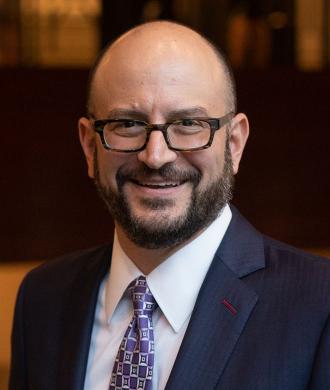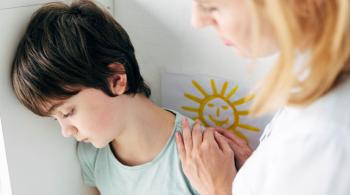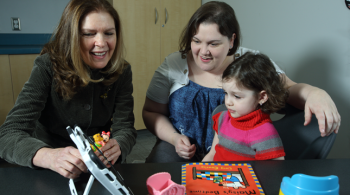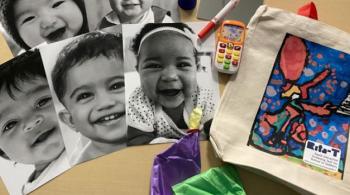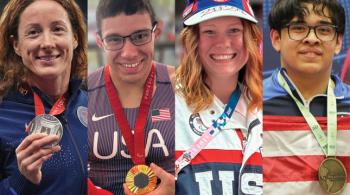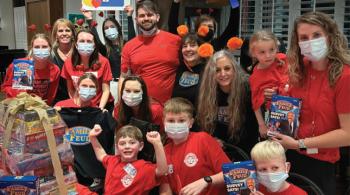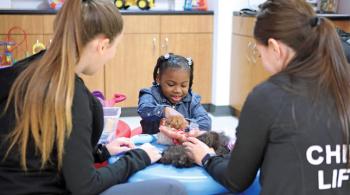On this episode, our guests discuss brain injury, particularly in children. Guests include
-
Dr. Beth Slomine - senior psychologist and director of training and neuropsychological rehabilitation in the Department of Neuropsychology at Kennedy Krieger. She is also a professor of Psychiatry and Behavioral Sciences as well as Physical Medicine and Rehabilitation at Johns Hopkins University School of Medicine.
-
Dr. Stacy Suskauer - vice president of pediatric rehabilitation at Kennedy Krieger Institute and the director of the Division of Pediatric Rehabilitation in the Department of Physical Medicine and Rehabilitation at Johns Hopkins University School of Medicine where she is also an associate professor of physical medicine & rehabilitation and pediatrics.
Drs. Slomine and Suskauer co-direct Kennedy Krieger’s Center for Brain Injury Recovery.
Resources
- Brain Injury Association of Maryland
- Brain Injury Association of America
- CDC mTBI Guideline and related provider and family/patient materials
- CDC Report to Congress on Pediatric TBI) – includes lay friendly overview of TBI
- Kennedy Krieger Center for Brain Injury Recovery
- Kennedy Krieger Concussion Clinic
Learn More About Our Featured Speakers
Learn More About Our Featured Speakers
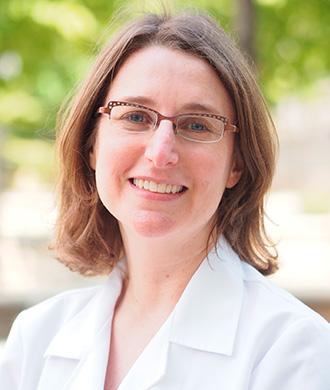
Stacy J.
Suskauer
,
MD
View Episode Transcription
Dr. Brad Schlaggar (BSc): Welcome to Your Child's Brain, a podcast series produced by Kennedy Krieger Institute with assistance from WYPR. I'm Dr. Brad Schlaggar, pediatric neurologist, the president and CEO of Kennedy Krieger Institute. This month's podcast discussion is about brain injury, particularly in children. Brain injury can refer to a wide variety of mechanisms that cause injury to brain tissue, like trauma, stroke, hypoxia, or insufficient oxygen supply to the brain, and many others. Typically, brain injury shows itself as disruption in one or more areas of brain function, which includes cognition, attention, memory, impulse control, processing speed, speech and language, motor abilities, physical functioning, behavior, and more. I'm very pleased to be joined today by my extraordinary colleagues from Kennedy Krieger, Drs. Beth Slomine and Stacy Suskauer. Dr. Slomine is senior psychologist and director of training and neuropsychological rehabilitation in the Department of Neuropsychology at Kennedy Krieger. She's also a professor of psychiatry and behavioral sciences as well as physical medicine and rehabilitation at Johns Hopkins University School of Medicine. Dr. Suskauer is the vice president of pediatric rehabilitation at Kennedy Krieger Institute and the Director of the Division of Pediatric Rehabilitation in the Department of Physical Medicine and Rehabilitation at Johns Hopkins University School of Medicine, where she is also an associate professor of physical medicine, rehabilitation, and pediatrics. Drs. Slomine and Suskauer co-direct Kennedy Krieger's Center for Brain Injury Recovery. Welcome Beth and Stacy. Now brain injury is such a large topic. We can't possibly cover it all in a single episode, but we can address some of the major points. Beth, let's start with some definitions. What is brain injury? How does traumatic brain injury or TBI differ from acquired brain injury and how do these forms of injury differ from say, concussion?
Dr. Beth Slomine (BSl): Brain injury can occur from an injury to the brain or an illness that affects the brain. We think of traumatic brain injury is an injury from a blow to the head. So a child either might fall or have a injury in sports or be hit by a car, those things cause an external injury to the brain from a traumatic brain injury. An acquired brain injury is something like you mentioned earlier. A stroke or loss of oxygen to the brain, a brain infection, a tumor of the brain that needs to be taken out surgically. All of those things also can cause brain injury. We classify brain injury as mild, moderate, and severe. Those terms are used most often with traumatic brain injury. Mild traumatic brain injury is another term that's used for concussion. People when they hear concussion can also think about the term mild traumatic brain injury.
BSc: Stacy for pediatric brain injury. What are some of the most common scenarios that you see in your brain injury recovery program?
Dr. Stacy Suskauer (SS): Fortunately, of all the brain injuries that Beth just describe, the most common severity is mild. Concussion is far and a way the most common type of brain injury that children experience. We know that millions of children in the US alone experience concussion or mild traumatic brain injuries. That's the most common entry point into our system as well, would be a child who comes to visit concussion clinic. Oftentimes children are followed by their pediatricians for the first couple of weeks of recovery from a concussion. If they're not rapidly recovering or the pediatrician or family has additional questions, they may then refer them on to see us. Most children, fortunately, recover from concussion within weeks. Almost all children are recovered within a few months. Though, because of the large number of children experiencing concussion, many people may also be familiar with a child who has symptoms after a concussion that lasts longer. The other common entry point into our brain injury programs is through the inpatient rehabilitation unit. This would be for a child who had a more severe brain injury, maybe from a motor vehicle collision or from an infection. Those children may spend several weeks on our inpatient unit experiencing a period of recovery, and then may transition through many of the other programs in our continuum of care. We have a day rehabilitation program as you know, where children may be medically stabilized enough to sleep at home and get into more of the routine of coming for rehab each day like they would go to school. Before they transition back to school and may continue to follow up over time in many different clinics across the institute.
BSc: Stacy, sticking with you. Are there important clinical or mechanistic distinctions between pediatric and adult brain injury and we often say in pediatric medicine that kids aren't just small adults. How might that principle apply to brain injury?
SS: Absolutely. In this case, there's one similarity between the youngest children and the oldest adults. That's how traumatic brain injuries occur. Young children have the highest rate of emergency room visits for traumatic brain injury and that's because of the number of falls that young children encounter. Whether it is a parent who slips while walking down the steps holding a young infant or a child learning to walk who's falling, or a child learning to jump who doesn't quite know how far to jump or not. That's where we see the majority of injury in young children. Then as children age, we start to see more injuries from sports related mechanisms or once kids start driving from motor vehicle collisions. But there are important differences in how the body is built, again, especially in young children. The skull is very thin and fragile in an infant, and it's much more common that an infant will have a skull fracture from a fall and there may be some bleeding related to that. Likewise, young children's heads take up more of their total body surface area than older children and adults. Just in terms of again, how a young child controls their body, how the head may take more force, leads us to need to think carefully, especially about young children. Then we also need to think in the case of young children about child abuse or what we call abusive head trauma. It's very important that anytime a medical provider or a head start providers interacting with the child, that they are aware of potential signs and symptoms of inflicted injury to a young child.
BSc: Excellent point too. Beth, as you mentioned earlier, and Stacy, reinforced brain injury can be anywhere on a continuum of severity from mild to severe, and so severe, that the person with a brain injury might even be in a coma or have a disorder of consciousness. First, what do we mean by coma or disorder of consciousness? Then can you take us through what that continuum of severity looks like in real terms?
BSl: A disorder of consciousness, is a stage of recovery, that happens in the most severe injuries where initially, somebody may be in a coma, which is really defined as a period from injury or illness, where there's no wakefulness, so the child's eyes are closed the whole time, and there's no periods, even brief periods, where the child is awake. The next stage of a disorder of consciousness is called a vegetative state, or more recently termed unresponsive wakefulness syndrome. During that stage, a child will have periods where their eyes are open, but responses are primarily reflexive, and there's no evidence that the child has awareness of their self, or their environment. The next stage is what we call, minimally conscious state. During that period, a child will show some clear awareness of their self or the environment, but that's happens inconsistently. There's definitely periods where the child might be looking around or even beginning to follow commands but it is not happening at a consistent way. As child emerges from a minimally conscious state, they do things more consistently, like answer yes-no questions, or maybe use objects functionally for play, or attempt to use a spoon, to try to eat, or a pen to try to write. During that time, often there's still a significant confusion and cognitive impairment. But they're thought to be emerged from that disorder of consciousness. Disorders of consciousness is something that occurs rarely in children. Those children that have a disorder of consciousness, often show up in our rehab hospital in the inpatient unit, and we follow them over time in a range of clinics that Stacy mentioned before, sometimes as they recover in our day hospital and then in outpatient clinics. We recently did a study, where we looked at long-term outcome of children that were in a disorder of consciousness at the time they were admitted to an inpatient rehab, and we found that 95 percent of those who were admitted in a minimally conscious state, recovered to emergence from that state, and almost 70 percent of those in a vegetative or unresponsive wakefulness syndrome emerged. Those were all children with traumatic brain injury. We looked at them one year after injury, and then again at our most recent follow-up, which was on average about six years later. Importantly, even between one year, and their most recent follow-up, as a small group of children made some substantial gains, during that time period, which is really important because, we often think about most recovery happening early after injury.
BSc: I just need to ask, were there any predictors in the early stage of the presentation that made it possible to know which of those patients who have minimally conscious state or vegetative state did eventually wake up?
BSl: I think the biggest predictor from that study was the state of consciousness at the time they were admitted to rehab because there was that significant difference between those children who were minimally conscious and those children that were in a vegetative or unresponsive wakefulness syndrome. There is a way of splitting out minimally conscious state to children that have some level of language and those that don't, and that in and of itself didn't make a difference in who emerged. Some of them might have to do with the fact that, in young children in particular language, is not something that we always expect to see as the first signs of recovery, because language is still developing.
SS: I just want to jump on to what Beth was talking about and, we've started looking at in terms of who's going to emerge while they're on our inpatient unit. Certainly we know improvement faster tends to predict more improvement long term. Using one of the scales that was developed here at Kennedy Krieger to really look at fine gradations, in how a child's motor function is improving. We've identified, working together with one of our senior physical therapists, that early head control, seems to be predictive of emergence from a disorder of consciousness, which makes sense but it could be because of many different reasons, because of visual input, because awareness is motivating for lifting your head. It's just really exciting to be able to break things down and look at new ways. This really hasn't been discussed in the field of disorders of consciousness. That's just one of the new things that's been coming along here from a research perspective.
BSc: Very interesting. Stacy, on the other end of the spectrum of severity another really common question that we hear is, can you have brain injury without any overt signs of it? Am I missing my child's brain injury because it's not obviously showing itself. Well, what would you say to that?
SS: Brad, that's a great question. I'd like to approach that from two different points. One is, when we get back to concussion. Concussion is a mild form of brain injury, and so there may not be that really obvious upfront sign of loss of consciousness or confusion. A common scenario is that, a child has a fall or has a sports collision and has a headache, right after that happens. To some extent, if you hit your head, it's normal to have a headache. Many children, may go to an urgent care and may go to an emergency room or may be observed at home, and it may not be very obvious from in those first few hours about, is this a concussion or is this a headache because I hit my head and sometimes when I've headaches I also feel a little sick to my stomach. More and more, what we're hearing is that, if this happened say on a Friday night football game, and then the family is encouraged to take it easy over the weekend, not have their child exercises normal, get a good amount of sleep. The child may be feeling pretty good, but it may be Monday morning when they go back to school and there's a lot of light and noise and more cognitive or thinking demands that all of a sudden, the child clearly has numerous symptoms associated with concussion. Parents know their children best, and I think what I would say is that sometimes it really takes those first few days to identify that there's been a concussion and that certainly keeping your child safe and out of risk of re-injury during that time is very important. The other angle I want to take on that though, is that the most common outcome after a brain injury is that there's differences in the way a child thinks or behaves. It's less common that a child is going to have difficulty walking or abnormal use of an arm. Because of this, sometimes we refer to brain injury as an invisible injury, so a child may look just like their regular self three weeks after concussion or even two years after a car accident with a more severe brain injury. But it doesn't mean that they're able to process information as quickly or they remember things as well, or they're not struggling with headaches and light sensitivity. Sometimes in clinic we say we wish we could put a giant band-aid on a child's head or wrap their head in a dressing because if they had a cast on their arm, nobody would doubt that they had a problem with their arm. Certainly, also, just trying to spread that word. There may be people we encounter in the community in the course of our lives that we don't know had a severe brain injury. But do maybe take a little bit longer to respond to questions or need a little bit more reminding of important things.
BSc: You're already starting to touch on the next question I had in mind, which is, when should you go and seek evaluation and treatment? Maybe complete that, but also who is it that should be evaluating your child? There are so many different venues that might be considered. What do you recommend and how do you think through that recommendation?
SS: One of the most important phrases is when in doubt, sit it out. If there's any chance that a child has experienced a brain injury, we want to protect them from not getting another brain injury on top of that. That is because there are rare occurrences where something called second impact syndrome happens where a child has had a mild injury, a concussion, and maybe it's not recognized, maybe the child is not reporting symptoms and gets another hit, say often in a sports event and there's a catastrophic injury with swelling of the brain, which seems to happen mostly in children and young adults. Again, if there's any question that a child may have experienced a concussion, we want to take them out of play, take them out of danger, and watch them for a bit and see how they respond, and if there's any question, get medical care. Medical care can happen in a number of different forms certainly if there are some of those red flag warning signs, emergency signs, the child is very confused, there has been a prolonged loss of consciousness, the child is slurring their speech, they appear weak in part of their body that those require going to an emergency room. Certainly, it's never wrong to take your child to an urgent care emergency room to get checked out. I'm a big fan of centralizing care through the pediatrician and having that medical home. The pediatrician has the benefit of knowing the child before having examined them before, and we want the pediatrician to have that record of any events and concerns about concussion or brain injury over time. Now, often if children aren't recovering in the first couple of weeks, it may be a time that the pediatrician thinks that additional evaluation would be useful, and there are a number of different kinds of healthcare professionals who can evaluate and treat children with brain injury. The most important thing is that that individual has expertise and training in that area, and so it might be a neurologist, it might be a rehabilitation physician like myself. It might be a neuropsychologist like Beth and all of her colleagues. People from a lot of different backgrounds can have skill in this area, and that's really what we want to seek out, is an individual who is experienced and then staying up-to-date in the literature about how to best care for children.
BSc: You made the point about when in doubt, sit it out. What's the advice about when it's time to go back into play? How do you make that decision and who makes that call?
SS: The gold standard, what we're generally looking for is that the child is symptom-free, including when they are doing heavy non-contact physical activity. Before we put somebody back in a basketball practice, they need to be able to run laps and feel well and of course, they need to be reintegrated in school, performing at their typical level and not having any symptoms. Sometimes children may still be getting caught up on makeup work, but what we want to know is that the understand the material, they're going through the homework as quickly as they typically would, and they really seem back to themselves. There's a typical process of getting back to typical activities, and it's gradually increasing non-contact physical activity, gradually increasing cognitive activity until the child is back at their baseline. Then they should always be evaluated again by a healthcare professional, who's skilled in concussion evaluation to make sure that they're really performing as they should be and are safe to return to play.
BSc: Beth, along those lines in this recovery period after injury and returning to activities, one of the controversies is this idea of brain rest. That brain rest matters for improved outcome. How do you think about brain rest as a part of a treatment plan?
BSl: Brain rest is a big hot topic right now. We really believe in active recovery and minimizing brain rest. The idea of brain rest really came out of well, in addition to being cautious with return to play, you need to be cautious cognitively as well, and then that was really taken out of context, and people were suggesting that children rest in a dark room without stimulation until their symptoms resolved. But you can think of what that does if you take a child and put them in a dark room and have them think about their symptoms, they're going to have symptoms. The other thing that happens is if you take a high school student who has a full course load in school, and you take them out of school for a prolonged period of time and they miss valuable instruction, especially in classes like math, going back to school is going to be very challenging and anxiety provoking. We recommend that children have a short rest, maybe one, two, three days depending on what they can tolerate, but really work towards getting up, getting dressed, and getting back to school. There are children that can't go back to school for a full day right away, and then we can think about that gradual return to school. But we really want kids to get moving quickly and even physically get involved in activities. As Stacy said, we don't want to send children back to contact sports or any activities that put their head at risk for another injury. But there's many low-risk physical activities that promote recovery, like beginning to take some walks and then moving to some jogging and doing yoga. Those activities we really want to try to put in place as early as possible to help children recover quickly.
BSc: Stacy, over the past 15, 20 years, we've heard a lot about chronic traumatic encephalopathy or CTE, as this neurodegenerative disease of the brain that comes from repeated traumas, heard about the professional athletes like football players for example. What is it and can children get CTE?
SS: I think CTE has been scary for a lot of families to hear a little bit about. CTE is a diagnosis that can only be made upon death. There are criteria that need to be fulfilled when examining the brain on an autopsy. There is a more recent term called traumatic encephalopathy syndrome, trying to get at describing the features noticed when an individual is still alive. It tends to be changes in thinking and behavior, like we discussed, are the most common difficulties that people have after a brain injury. The idea is that some individuals with a very high load of repeated trauma to the head seem to experience this. It's not every professional football player. I personally think there's probably some genetic susceptibility, which we'll learn more about in the coming years. I think a really important thing is when thinking about children, however, that this newer clinical traumatic encephalopathy syndrome. The criteria include at least five years of high collision activity like football at a high school level or later. That means that a child who plays football and ends at the high school career, technically, we would not think about being at risk for CTE. I also just want to mention that there have been in the autopsies some concern that the very beginnings of these tau deposits that can be seen in the brain were found in occasional younger adults so college level, high school level individuals. I think we have a lot that we're still going to learn about how that correlates with this behavioral syndrome and possible modifiers over time.
BSc: So to say the tau is this protein that is evident at autopsy of accumulation that's related to CTE amongst other neurodegenerative processes. Beth, broadly speaking, is brain injury treatable and on the other side, what are the risks of not seeking evaluation or treatment?
BSl: Well first off, I would say the best treatment for brain injury is prevention and most people who are probably listening now have a child who hasn't had a brain injury or might've had a concussion that's recovered. Prevention, things like wearing an appropriately fitting helmet for that particular activity. If you're playing football, you're wearing an appropriately fitting football helmet. You're riding a bike, you're wearing an appropriately fitted helmet for bike riding. Riding a bike, having children ride bikes in safe areas. Making sure that young drivers have protections in place and are only driving in places that they're most familiar with. Those are some ways to prevent brain injury. After a brain injury, there are definitely treatment options that can be useful. It really depends on the type of injury, extent of injury, and the problems that have developed after injury. But there are a range of professionals and types of treatments that are helpful. Treatments from medications to environmental changes in the household and in school modifications, therapy services, that can all be helpful. It's important that if a child has a brain injury, that their family seek out an evaluation from professionals so that they can be guided to the appropriate treatment.
BSc: What is the typical process of recovery after brain injury look like and then how good are we at predicting recovery? We talked a little bit about prediction earlier. Refresh that out a bit more.
BSl: Severity of injury is important thinking about in predicting outcome as well as type of brain injury. Those are some of the things that we think about. After a more severe brain injury and somebody comes to our inpatient unit, families often asked, what do you think's going to happen? How will my child look when they leave the hospital? How will they look a year from now? What about five years from now? We unfortunately don't have great tools to know that for sure. But like Stacy mentioned earlier, some of the Kennedy Krieger scales that we developed have ways of measuring subtle changes in behavior early after injury that can be helpful. We've found in general that early markers of recovery are predictive of later recovery. Unfortunately, you need a little bit of time to see those early markers of recovery. But there are signs that we can look for that help us to predict recovery.
BSc: Stacy. I'm going to end with I think the most enjoyable question is, what's new in brain injury research? What's on the horizon that you find exciting that you think may transform how we approach brain injury?
SS: Well, to piggyback on what Beth was just talking about. one of the new ways that we're thinking here about predicting and modifying outcome is really talking about stratifying within general levels of functioning. Part of the difficulty with predicting outcome is the wide range of outcomes based on the type and severity of injury you had. It's unlikely that a specific rehabilitation intervention if given to a child with the most severe brain injury is going to move that person up to the highest level of functioning. But it's really important that we know that what is going to maximize their outcome, knowing that they had a severe brain injury. I think that is really going to change some of the models and thinking about outcomes, which is really important. The other thing that I alluded to earlier is thinking about genetics and that's a huge piece that also likely modifies response to mild injury, mild repetitive injury, even more severe injuries. Potentially thinking about which medications we choose and how to narrow that down so that we can really hone in more quickly on a medication that might facilitate a child's recovery rather than it being a trial and error process. I think as with many aspects of medicine, what we're going to start to see is how we pull together this information at different levels. At what was the type of injury? What was the child's genetics? What is the rehabilitation interventions, and combine them to give us multiple levels of input and decision-making and really get towards more of that personalized predicting of outcome and tailoring rehabilitation.
BSc: We're going to include a number of links to useful resources on the website for this podcast episode from the Brain Injury Association of Maryland, Brain Injury Association of America, as well as from the CDC. Please check those out. [MUSIC] Thank you to this month's guests for this fascinating discussion about brain injuries. We hope all of you listening have enjoyed the discussion as much as we have. We hope you'll share this podcast with your friends. You consider rating it as well. We invite you to check out our entire podcast library at WYPR.org/YCB, KennedyKrieger.org/YCB, WYPR.org/Studios or wherever you get your podcasts. [MUSIC]

